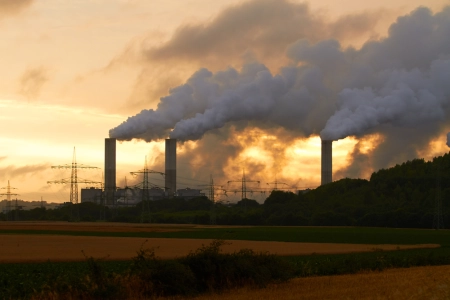
Non-renewable energies are a category of energy resources that are characterized by their finite nature and gradual depletion over time. Unlike renewable energy, which is generated sustainably over time, non-renewable energy is depleted as it is used.
In this article, we will explain what non-renewable energies are with real examples, making a small definition of the different types of non-renewable resources.
Definition of non-renewable energy
Non-renewable energies, also known as fossil energies, are those that are derived from sources that exist in limited quantities and are being depleted as they are used.
These energy sources have been formed over millions of years from geological and biological processes, and their extraction and burning releases energy stored in the form of fossil fuels.
Examples of non-renewable energy
Next, we will explain some examples of uses and applications of non-renewable energies:
1. Gasoline or diesel vehicles
Cars, trucks and motorcycles that run on internal combustion engines use gasoline or diesel as fuel.
These fuels are derived directly from crude oil and are responsible for mobility on roads and highways around the world.
Although electric vehicles are growing as a cleaner alternative, millions of combustion engine vehicles that rely on these non-renewable fuels are still in use.
2. Cargo ships
Cargo ships that transport goods internationally are usually powered by diesel engines that use diesel, another petroleum derivative.
Maritime transport is essential for global trade, and the dependence on fossil fuels in this industry is a clear example of the importance of non-renewable energy in international logistics.
3. Planes
Commercial airliners, from small regional aircraft to large airliners, use petroleum products, such as aviation kerosene, to power their engines.
Despite advances in cleaner technologies in aviation, most aircraft remain reliant on fossil fuels, making them a major contributor to greenhouse gas emissions in the transportation sector.
4. Nuclear power plants
Nuclear power plants generate electricity through controlled nuclear fission reactions. Enriched uranium is the fuel used in these reactors to release a large amount of energy in the form of heat, which is then converted into electricity.
Although nuclear energy does not produce greenhouse gas emissions during its operation, it poses challenges regarding the safe management of nuclear waste and the proliferation of nuclear weapons.
5. Gas boilers
In many homes and commercial buildings, gas boilers that run on natural gas are used to provide heating and hot water.
Natural gas is a versatile and clean energy source compared to other fossil fuels, and is widely used in heating and cooling applications, as well as in industry and electricity generation.
Types of renewable energy
The main categories of non-renewable energy include:
-
Coal : Coal is a non-renewable energy source that is formed from the accumulation of plant matter in the soil over millions of years. It is burned to generate electricity in thermal power plants. Another example of its use is in steel production and other industrial processes.
-
Petroleum : Crude oil is one of the most widely used fossil fuels in the world. Some examples of its applications range from transportation, electricity generation, heating, to the production of chemicals and plastics. Petroleum derivatives include gasoline, diesel, kerosene and diesel.
-
Natural gas : Natural gas is a mixture of gaseous hydrocarbons, mainly methane. It is widely used in heating applications, electricity generation and as a vehicle fuel. It is often considered a cleaner energy source compared to oil and coal due to its lower carbon dioxide emissions.
-
Uranium : Uranium is a chemical element used in nuclear energy generation. Through nuclear fission, a large amount of energy is released in nuclear power plants. Although it is not a fossil fuel, it is classified as a non-renewable energy source due to its finite nature.
-
Agrofuels : Agrofuels are biofuels derived from agricultural crops, such as ethanol from corn or sugar cane, and biodiesel from vegetable oils. These fuels are used in transportation applications and, in some cases, for electricity generation. They are considered non-renewable due to the limitation of available agricultural resources.
-
Biofuels : Biofuels are a broader category that includes both agrofuels and second-generation biofuels, which are produced from non-food biomass such as agricultural waste or wood.
Advantages and disadvantages
Electricity generation methods based on non-renewable energy have notable advantages in terms of reliability and initial costs, and disadvantages related to resource depletion.
Below we present in more detail the advantages and disadvantages of this type of energy:
Advantages
-
Constant production: Power plants powered by fossil fuels or nuclear fuels are reliable sources of energy. This means they can consistently and predictably provide power when needed, which is essential for maintaining the stability of the power grid.
-
Low fuel cost: The fuel price for these types of power plants is usually relatively low compared to other energy sources. This can result in more affordable electricity generation costs, benefiting consumers and the broader economy.
Disadvantages
-
They do not regenerate and tend to be depleted: Fossil fuels, such as coal and oil, took millions of years to form and are non-renewable resources. Once they have been used up, they cannot be replaced, raising concerns about the future availability of these energy sources.
-
Low energy efficiency: The energy efficiency of electricity generation methods based on fossil or nuclear fuels is considerably lower compared to clean and renewable energy.
-
Harm to the environment: Burning fossil fuels releases carbon dioxide into the atmosphere, contributing to climate change and global warming.
-
Greenhouse gas emission: In addition to carbon dioxide, coal and natural gas also release sulfur dioxide and other air pollutants when burned. These gases can cause respiratory problems in living beings and contribute to the formation of acid rain, which negatively affects ecosystems and air quality.
-
High installation cost: The construction of power plants, especially nuclear ones, involves a high initial cost. Furthermore, the decommissioning of end-of-life nuclear power plants and the safe storage of radioactive waste also carry significant costs, posing long-term economic challenges.